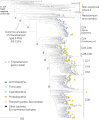Evolution of chemical diversity by coordinated gene swaps in type II polyketide gene clusters
- PMID: 26499248
- PMCID: PMC4653136
- DOI: 10.1073/pnas.1511688112
Evolution of chemical diversity by coordinated gene swaps in type II polyketide gene clusters
Abstract
Natural product biosynthetic pathways generate molecules of enormous structural complexity and exquisitely tuned biological activities. Studies of natural products have led to the discovery of many pharmaceutical agents, particularly antibiotics. Attempts to harness the catalytic prowess of biosynthetic enzyme systems, for both compound discovery and engineering, have been limited by a poor understanding of the evolution of the underlying gene clusters. We developed an approach to study the evolution of biosynthetic genes on a cluster-wide scale, integrating pairwise gene coevolution information with large-scale phylogenetic analysis. We used this method to infer the evolution of type II polyketide gene clusters, tracing the path of evolution from the single ancestor to those gene clusters surviving today. We identified 10 key gene types in these clusters, most of which were swapped in from existing cellular processes and subsequently specialized. The ancestral type II polyketide gene cluster likely comprised a core set of five genes, a roster that expanded and contracted throughout evolution. A key C24 ancestor diversified into major classes of longer and shorter chain length systems, from which a C20 ancestor gave rise to the majority of characterized type II polyketide antibiotics. Our findings reveal that (i) type II polyketide structure is predictable from its gene roster, (ii) only certain gene combinations are compatible, and (iii) gene swaps were likely a key to evolution of chemical diversity. The lessons learned about how natural selection drives polyketide chemical innovation can be applied to the rational design and guided discovery of chemicals with desired structures and properties.
Keywords: evolution; gene cluster; natural products; polyketide.
Conflict of interest statement
The authors declare no conflict of interest.
Figures




References
Publication types
MeSH terms
Substances
Grants and funding
LinkOut - more resources
Full Text Sources
Other Literature Sources

